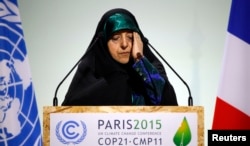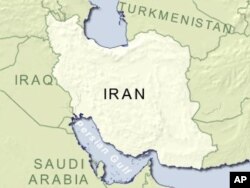A water crisis is looming in many dry areas of the world and Iran is no exception.
As world leaders gather in Paris to negotiate a universal agreement regarding climate change, Iran is struggling with severe environmental issues that many believe were created due to manmade resource management decisions.
Iran’s Environmental Protection Organization said 7 million hectares of land is in danger of desertification.
Dying lakes
Bakhtegan Lake in southern Fars province, once a common stopping point for migrating flamingos, is drying up, its salinity levels becoming a hazard to the birds. Fed by the Kor River, the lake has dried up completely at times in the past decade.
Development along the Kor River, both urbanization and the building of dams, has been blamed for the significant reduction in water to the lake.
Earlier this year, the Bakhtegan dried up and caused a salt storm in nearby areas, according to local media. Sand storms and flooding are also occurrences near the lake.
Urmia Lake, once the sixth-largest salt-water lake in the world, covered about 5,200 square kilometers – twice the size of the country of Luxembourg.
Now it now measures about 10 percent of its original size, leaving exposed acres of lakebed that have caused noxious salt storms that threaten both agriculture and populations along the lake.
'Stop further damage'
“Paris climate talks serve as a significant opportunity for world leaders to create an understanding in order to stop further damage to countries and populations,” said Masoumeh Ebtekar, vice president and head of Iran’s Department of Environment, on the sidelines of the Paris talks. She was quoted by Iranian government TV.
“Water resources have decreased significantly in Iran, not only because of the rapid population growth and increased water use, but also as a result of frequent droughts and climatic changes," said Kaveh Madani, senior lecturer in environmental management at the Center for Environmental Policy at Imperial College in London.
"In short, we are water bankrupt” Madani warned in an interview with VOA.
He continued: ”The water problems that Iran are experiencing right now are unprecedented. These problems are the product of myopic planning over several decades and their solutions are not easy to develop."
“Substantial reforms in the agricultural, focus on policy reforms and changes in the water governance structures can be far more effective than building concrete dams that have permanent environmental damages,” he added.
Structural or "hard solutions," such as dams, were a popular choice during previous administrations, such as President Mahmoud Ahmadinejad's two terms in office, when Iran was considered a leading country in dam construction.
Dams stored water in reservoirs, providing for agriculture, power generation and urban populations.
The Financial Times reported that Iran had built 600 dams during the past three decades. Yet, not one dam had been opened under President Hassan Rouhani, who became Iran's leader in 2013, the paper reported.
Rouhani stressed saving the environment and managing water resources during his campaign.
Victims of climate change
Ebtekar, Iran's Department of Environment head, believes poor and developing countries are the victims of climate change as a result of greenhouse gas emissions by rich industrial countries.
Imperial College's Madani has a different view, however.
"Climate change is not the main cause, but certainly a catalyzer, which has exacerbated the situation," he said.
"The observed trends in temperature and precipitation changes over the last decades are scary. We are getting less rainfall in many parts of the country while the temperature has increased across the whole region. Our system in its current form is not resilient and cannot cope with climate change if it makes Iran drier and hotter," Madani said.
Isa Kalantari, Iran’s former agriculture minister and head of Lake Urmia’s restoration program, warns that between a high rate of water consumption and ensuing climate change, the country’s rivers will all dry out.
"If the trend does not stop, 50 million of the population needs to move to survive,“ Kalantari warned.














